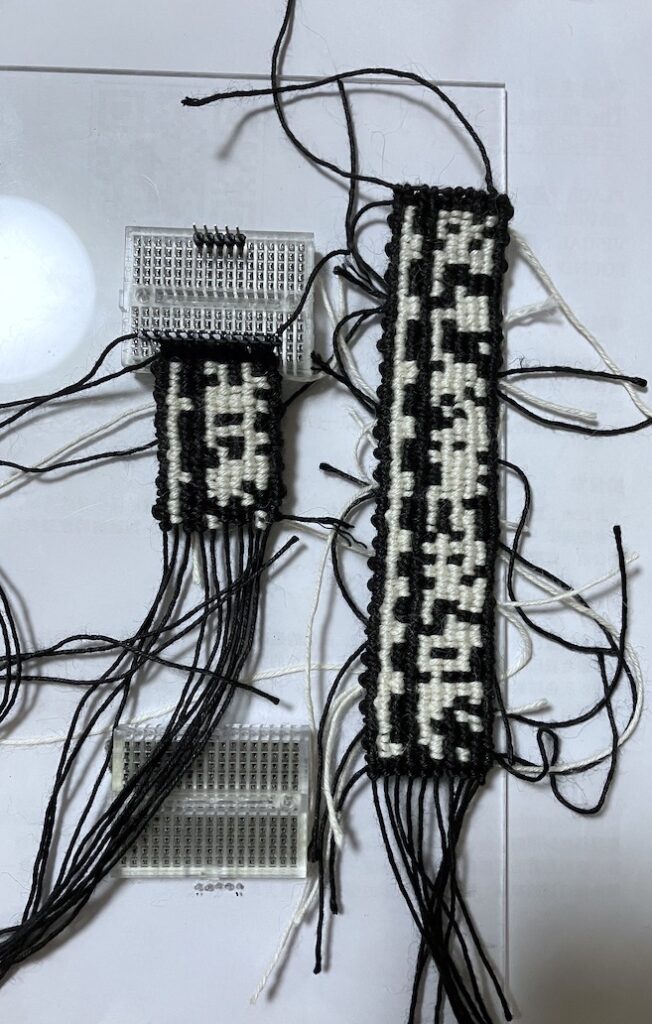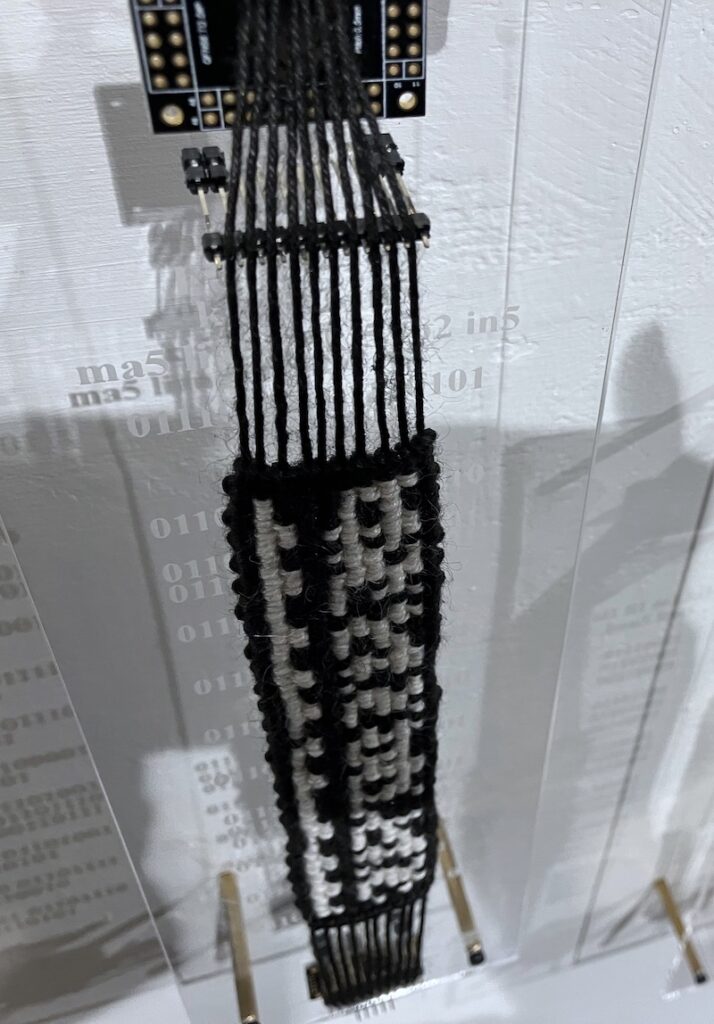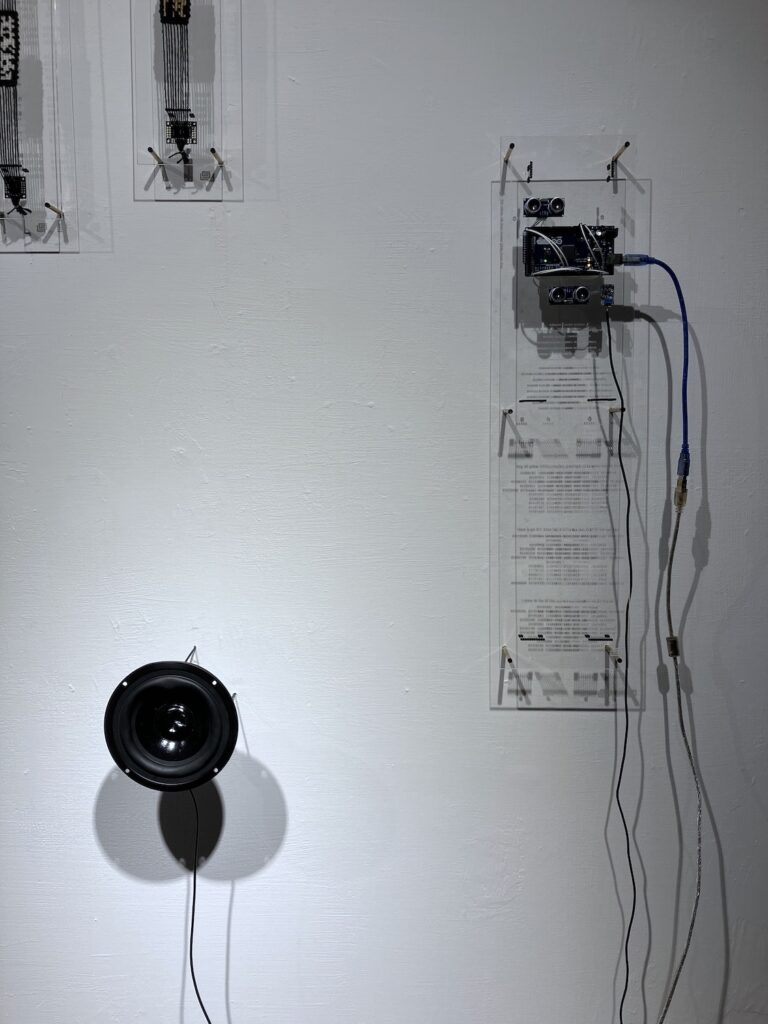“Data Weaving” connects digital language and cultural language, developing sound waves of real-time visual programming. It transcodes sound data of local narratives into woven visual patterns, becoming a touchable textile embedded with body artistries and generating local narratives in cross-cultural sound preservations of digital materials. The textiles of “Data Weaving” are stored, arranged, and indexed individual messages in a meaning materialized way, and become a trace of the producers’ body marks, as well as a way of interaction in which personal language is memorized and cultural textiles are mutually mended.
// SIGGRAPH Art Gallery ’24: ACM SIGGRAPH 2024 Art Gallery July 2024, Article No.: 10, Page 1
// https://doi.org/10.1145/3641523.3665177
// Artist : LIN, Hsin-I // 2022, textiles, interactive sound installation
// Arduino light theremin programmer:LAI, Wei-Han
// Sound Installation Song : 加蚋埔馬卡道族 Garanpu Makato.踏荷好 [tahoho] by WIND MUSIC International Corporation
// Thanks:HUNG, Go-Zen.KE,Tsu-Hao.sensorium/Mozzi
The message can be used as coding contents of textiles, and the textiles can also be used as the interface of the message output. ” [sin-gí]: Data Weaving” translates three ethnic groups’ language from Makatao, Tevorangh, and Siraya and the phonetic system of Taiwan Heluo accent into binary codes and uses the ancient “Macramé” weaving technique to create a weaving with cross-ethnic coexistence of multilingual and multimodal groups. Embroidery and textiles not only serve as a worldwide cultural-materialized symbol, but the physical act of “sewing” is also a process of mutual understanding and body empathy of multiple subjects. The production of textiles is a physical behavior of weaving visible and material data, and the action of participating in the weaving of objects is not only the perceptual action of the subject facing the material but also constructs the meaning of cultural technology: a trace of body, time, material and cultural environment that is embedded in textiles in a material and visual way. Textiles show us a collection of data language through patterns, body movements, and circular behavior. With the updated aggregation of technical information and pattern visualization, a textile transmits not only the visual data on the surface of the textile, but also accumulates the material meaning of the “cultural mending” relationship between people, cultural materials, and living environment, forming a circular culture.
Using the “Fan Su Liu Kao ( Six Investigation of Pingpu customs, ‘番俗六考’) ” in the “Tai Hai Su Tsa Liok ( Investigation Record of Taiwan Sea, ‘臺海使槎錄’)” by Huang Shu-qiu, a Qing imperial officer, as a coded context, it start-ups the historical/contemporary co-construction of the indigenous language data of Heluo accent. The records of the indigenous songs in the “Fan Su Liu Kao ” present documentary notes from some kinds of foreigners on the one hand, and a linguistic interpretation of “re-description” in language culture on the other, which is a cross-cultural juxtaposition of writing modes. Based on this understanding, the artist conducts re-search on the contemporary Heluo accent in indigenous language songs, tracing the route of Huang Shu-qiu to explore the daily soundscape of the present-day Taiwanese indigenous language.
Initially, translating the three Makatao(馬卡道), Tevorangh(大武壠), and Siraya(西拉雅) songs from the ” Fan Su Liu Kao ” by domestic researcher Hong Guo-sheng(洪國勝), three indigenous songs and the phonetic system of Heluo accent(河洛音) will be transcoded into binary codes. Next, traditional embroidery, weaving methods, and patterns of the three ethnic groups were then explored for data materialization. In addition to transcoding the cultural data, the work is also combined with the acoustic pronunciation device of a digital version of Theremin to become an instantly interactive and magnetic wave-sensitive acoustic textile.
// From Phonetic system to Binary Data:
Cultural Translation of Different Languages
Transcoding of Taiwan’s Heluo accent and indigenous languages into binary
languages.
Textile production is for making the visible body movements as material data. When participating in data weaving textiles, the artist collects various kinds of recycled clothing and emotional data at the same time, and transfers both from words and images to the material interface through body manipulation, which becomes a kind of non-digital storage interface. These data textiles are cultural technologies that encode cultural meanings, material substances, and bodily experiences.

[sin-gí] Textiles:
coded textiles in two languages of 3 ethnic groups
© Lin, Hsin-I

Laser engraving the translated text
on a transparent acrylic loom with circuit board and pins
© Lin, Hsin-I
// Language data to textile data:
the translation of different material media
Weaving binary languages with traditional artistry to store material interfaces.
They are composed of human-material interactions, while forming cultural networks that index the meaning of messages. When narratives are translated into message codes, we also translate them into a stable but complex cultural meaning, a cultural update that encompasses collective memory, multilingualism, and heterogeneous images. Each message storage becomes a shared parameter for the next data collection, which in turn resonates with the output of an open data interface in a multilingual mode.
Language Decoding of Subject Movement
By digitizing the principle of the Theremin and detecting body movements through the arduino light sensor, it searches for the semantic meaning of ancient local songs at different distances. The viewer can only hear the “correct” song chanting in a certain position, and only the pitch-tonal modulation can be heard in different positions.


